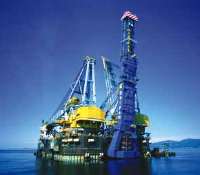Deepwater J-lay construction vessel
April 2000 Vol. 221 No. 4 Feature Article Deepwater J-lay construction vessel Offshore industry market demands are experiencing a sharp change with regard to operation
Deepwater J-lay construction vesselOffshore industry market demands are experiencing a sharp change with regard to operational water depths. Conventional shallow-water construction methods, such as fixed platforms, often are being replaced by newer deepwater development technologies. Saipem, the Milan-based oil and gas construction company, has responded to these demands by upgrading its Class III, dynamically positioned (DP) vessel, the S-7000, to perform deepwater pipeline installations utilizing a J-lay tower.
As the world’s largest semisubmersible crane vessel (SSCV), Saipem’s S-7000 is unique in its class for its heavy lifting and dual crane mode capabilities. It can lift 7,000-metric-ton structures in single crane mode and handle up to 14,000-ton structures when operating in twin crane mode. The upgraded vessel, which combines heavy-lifting capabilities with its conversion to a J-lay vessel, is able to install trunk and flowlines in deepwater pipe-laying applications. By combining industry’s largest J-lay tower with a fully upgraded DP vessel, the S-7000 can install 4-in. through 32-in. diameter pipelines in waters exceeding 6,500 ft, compared to previous water depth limitations of 2,600 ft. Marine upgrade. The first vessel to receive Lloyds Register DP (AAA) notation, the S-7000 has undergone a major upgrade. In addition to improvements in the DP control and power generation systems, two new thrusters will increase total thrust to 164 tons. These modifications will sharply increase the vessel’s DP capabilities and sea operability with regard to adverse climate, heavy lifting and J-lay activities. J-lay components. Weighing in excess of 6,000 tons, the J-lay tower incorporates three conventional track-type tensioners, two working stations and a friction clamp system, as well as an abandonment and recovery station. The tower is connected to an A-frame positioned on the upper deck by means of an adjuster system, which locates the 425-ft long J-lay tower between 90° and 115° and locks the tower in position at a 90° angle for transit or survival mode. Pipe comprising the line being laid is assembled onshore into 158-ft long quad joints (four sections of pipe) and transported to the S-7000. Upon delivery, quad joints are placed into the pipe loader / elevator system, then upended and placed in the tower elevator, which brings the quad joint to the top of the tower. A line-up clamp system was specifically designed to achieve tight alignment tolerance between the quad joints. When proper alignment between quad joints is achieved, welding is performed by a fully mechanized Saipem Passo GMAW system, which has a significant track record on Saipem / EMC vessels. The S-7000 J-lay tower features three, 175-ton capacity conventional track-type tensioners between the welding and NDT stations. Two friction clamps, consisting of two, 550-ton capacity clamping units, apply necessary tension. The system can be used as a backup for pipe laying and recovery operations or as a contingency pipe clamping structure for pipe weld repairs at the NDT station. Designed to simplify welding activity at any tower angle, the welding station can be inclined to match the tower angle and to accommodate the beveling machine for cutouts, welding equipment and miscellaneous facilities. The abandonment and recovery (A&R) system, used for pipeline abandonment and recovery operations, includes a 550-ton, double-capstan winch that is conveniently installed on deck. The quad joint is moved about 158 ft to the NDT station, where all necessary quality control inspections are performed. Finally, the string is ready to be laid in ultra-deep water. Laying operations. The J-lay system was designed to lay 4- to 32-in. OD quad joints in more than 6,560 ft of water. The identifying feature of the J-lay system is the sag-bend on the pipe, whereby the pull of the tensioners does not fall below a specified value so as to avoid over-stresses. Additionally, the tower’s inclination ability allows operations in relatively shallow water, producing a suitable overlap with conventional S-lay vessels such as the Castoro Sei. Current operations. The S-7000 was mobilized in the Gulf of Mexico in October 1999 for installation of ExxonMobil’s Diana facilities. The following components were installed:
Future upgrades. Further improvements of the system are already being
considered. In particular, an additional upgrade to a 2,000-ton pulling capacity will result in easier
management of flooded lines. Also, the use of an innovative electron-beam welding system, currently under
development by Saipem, will boost productivity considerably and produce further advantages for both
contractors and clients. Acknowledgment This article was adapted from the original paper presented by R. Faldini and M. Giorcelli at the 1999 Offshore Technology Conference in Houston. |



